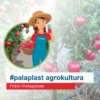
FROST PROTECTION
Protecting orchards from the devastating results of frost is a matter of great importance for agriculture. Confronting frost is a complex issue and has been studied through the years by many scientists, as for its solution it is necessary to take into account various factors, such as agricultural, chemical, meteorological, mechanical and economic.
Depending on the season, frosts can be divided into early or autumn frosts, winter frosts and late or spring frosts.
In Greece, autumn frosts which mainly affect citrus fruits, olives and kiwis during fruit bearing, causing a characteristic dehydration, are not very common. The autumn frosts can also affect vegetative buds of deciduous trees that enter later into the dormant period.
Winter frosts can damage the plants and fruits of citrus trees, as well as to olives and kiwis (especially young plants), while they can also harm the buds of apricot and peach trees.
Spring frosts can towards the end of winter, early spring or even later. They are the most destructive, as the trees are in the most sensitive stage of bud development, flowering and pollination. Strong frosts in early spring can cause tearing and detachment of the olive branch bark, resulting in drying of leaves and buds, as well as infections. Depending on the vegetative stage of the plant, and the closer they are to the carpal stage, the more sensitive they are to low temperatures. Species and varieties that bloom earlier in the spring are more likely to be damaged by frost, resulting in reduced production, either because of poor pollination or poor fruiting.


Typically, the following can be mentioned for:
Kiwis are endangered by autumn and winter frosts mainly with damage to the fruits which are destroyed as soon as the temperature drops to -2 ° C, while at temperatures below -6 ° C the annual sprouts and trunks of newly planted trees are damaged.
Olive trees are endangered by early autumn frosts and winter frosts. Fruits freeze at -3 ° C, leaves at -3 to -6 ° C, bark at -7 ° C and wood of older sprouts at -13 ° C.
Citrus species are mainly damaged by winter frosts, as they do not have the ability to harden, as plants of the southern temperate zone and the subtropical regions. Tangerines are the most hardy species, whilst lemon is more sensitive than orange. Generally, at -2 ° C flowers, young shoots and tender tops are damaged, at -5 ° C the older shoots, while at -10 ° C tree necrosis is observed. One only frost is able to degrade the quality of the fruit and damaging part or even the whole tree.
By frost protection we mean the application of certain methods in order to protect crops and orchards from the destructive effects of frost. This protection aims to significantly reduce the damage not only to trees but to provide complete protection to crops. Anti-frost protection measures are divided into indirect or preventive (passive protection measures) and direct or active (active protection measures).
The systems of artificial rain, supported by Palaplast, as active protection measures, serve two purposes:
- Preventing the temperature from falling below the limit of plant resistance, by wetting under the canopy of trees with the use of sprinklers, an application mainly used in citrus and kiwi orchards during winter frosts
- Delaying the opening of the buds and reducing the damage during the frost, by completely wetting the trees from above, applied mainly to deciduous trees during spring frosts.
The amount of water required to deal with frost is (on average): 3-5 mᵌ / acre / hour. The success of the method depends on the continuous and uninterrupted spraying (permanent irrigation with sprinklers and permanent water supply) of plants with normal size water droplets (ideal size of droplets should be such, as to avoid excessive losses due to poor adhesion on the plant organs and not so small as to be carried away by light air breeze). Moreover it is important to apply on light soils with good drainage.
A disadvantage of this method is the formation of ice (stalactites-stalagmites) on the leaves and where water falls on the canopy of trees, which is why it is recommended to remove those branches close to the ground during pruning. Furthermore, if the duration of the frost is long, then the large amounts of water that flow into the orchard can cause leaching of the nutrients of the rhizosphere of the trees and damage due to fungal infections.
Palaplast has a wide range of products that can be used for frost protection such as:
- Microsprinklers : «Delta sprayer», «Sprayer 2000», «Pal Rotating Super Sprayer», «Pal Rotating Special Sprayer» etc
- Irrigation Pipes : «AGROPAL 6atm», «SUPER-PAL 6atm», «DRIP-PAL»
- Stands and Microfittings such us : «Safety Female Base ½” κ Female Support Base», «Spike», «Adaptor» etc
- Lock Type Fittings PN6 such us : «Tee Quick Coupling», «Elbow Male Threaded», «Male Connection» etc
- Saddles, such as Clamp Saddle 6atm Drawer
- Filters such as : «In line Filters screen 10atm “HYDRO”», 6atm such us : «In Line Large», «Elbow Large», «Tee Large»
- Plastic Valves «Ball Valve»
- Ball Valves u-PVC and Fittings u-PVC


